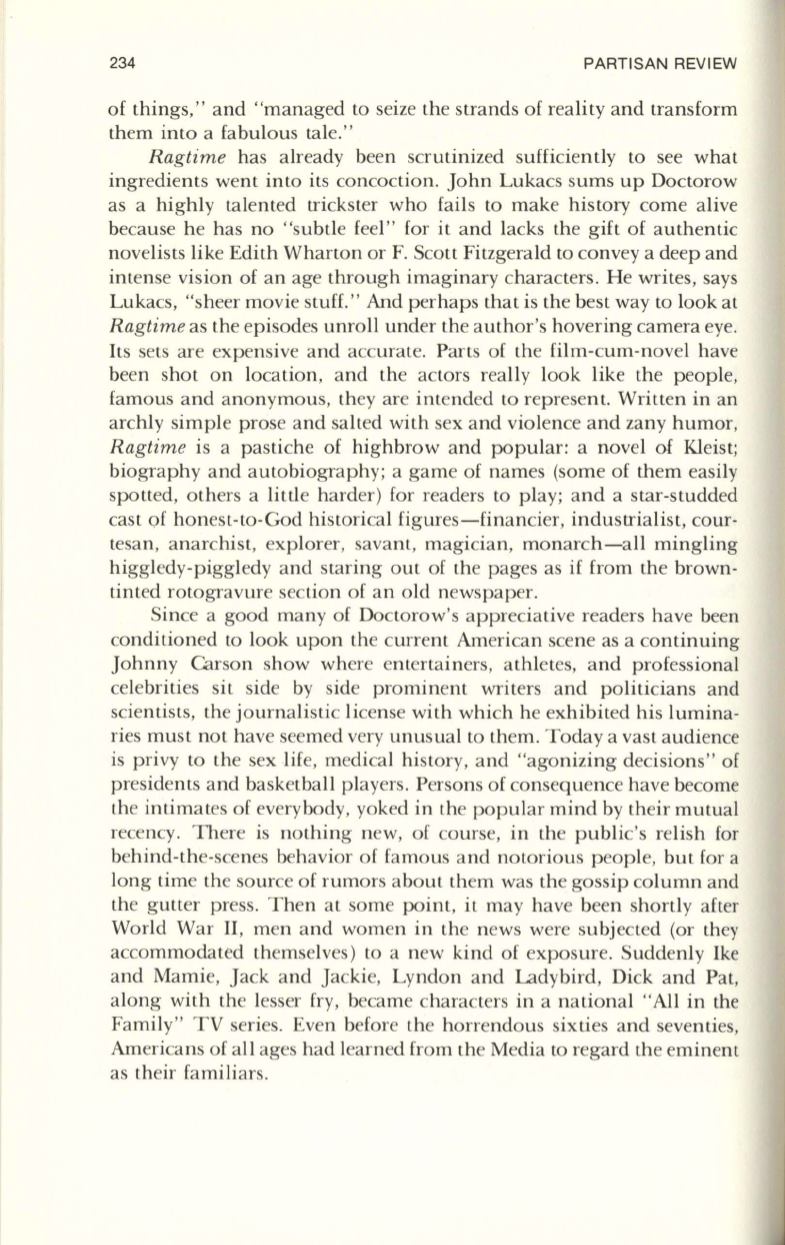
234
PARTISAN REVIEW
of things," and "managed to seize the strands of reality and transform
them into a fabulous tale."
Ragtime
has already been scrutinized sufficiently to see what
ingredients went into its concoction. John Lukacs sums up Doctorow
as a highly talented trickster who fails to make history come alive
because he has no "subtle feel" for it and lacks the gift of authentic
novelists like Edith Wharton or F. Scott Fitzgerald to convey a deep and
intense vision of an age through imaginary characters. He writes, says
Lukacs, "sheer movie stuff." And perhaps that is the best way to look at
Ragtime
as the episodes unroll under the author's hovering camera eye.
Its sets are expensive and accurate. Parts of the film-cum-novel have
been shot on location, and the actors really look like the people,
famous and anonymous, they are intended to represent. Written in an
archly simple prose and salted with sex and violence and zany humor,
Ragtime
is a pastiche of highbrow and popular: a novel
of
Kleist;
biography and autobiography; a game of names (some of them easily
spotted, others a little harder) for readers to play; and a star-studded
cast of honest-to-God historical figures-financier, industrialist, cour–
tesan, anarchist, explorer, savant, magician, monarch-all mingling
higgledy-piggledy and staring out of the pages as if from the brown–
tinted rotogravure section of an old newspaper.
Since a good many of Doctorow's appreciative readers have been
conditioned to look upon the current American scene as a continuing
Johnny Carson show where entertainers, athletes, and professional
celebrities sit side by side prominent writers and politicians and
scientists, the journalistic license with which he exhibited his lumina–
ries must not have seemed very unusual to them. Today a vast audience
is privy to the sex life, medical history, and "agonizing decisions" of
presidents and basketball players. Persons of consequence have become
the intimates of everybody, yoked in the popular mind by their mutual
recency. There is nothing new, of course, in the public's relish for
behind-the-scenes behavior of famous and notorious people, but for a
long time the source of rumors about them was the gossip column and
the gutter press. Then at some point, it may have been shortly after
World War II, men and women in the news were subjected (or they
accommodated themselves) to a new kind of exposure. Suddenly Ike
and Mamie, Jack and Jackie, Lyndon and Ladybird, Dick and Pat,
along with the lesser fry, became characters in a national "All in the
Family" TV series. Even before the horrendous sixties and seventies,
Americans of all ages had learned from the Media to regard the eminent
as their familiars.


